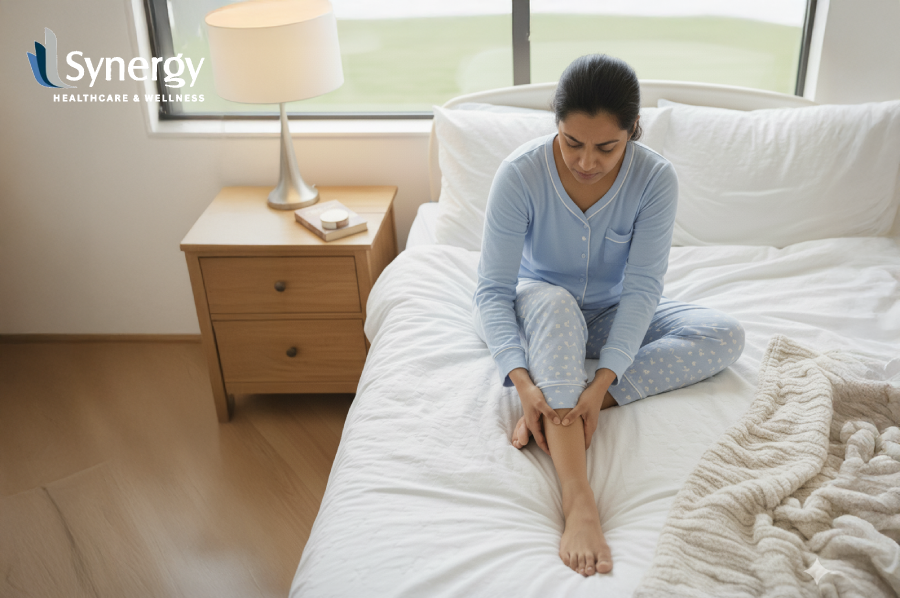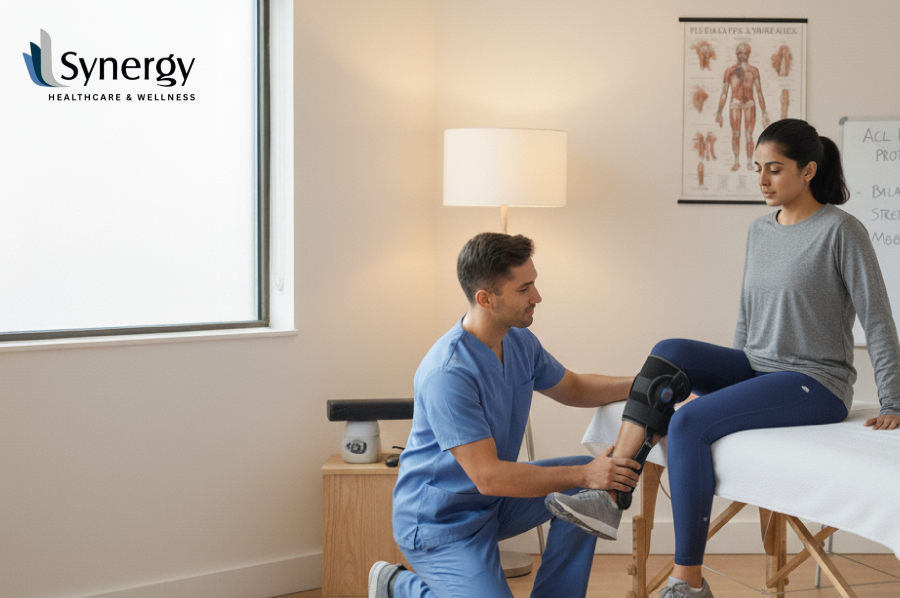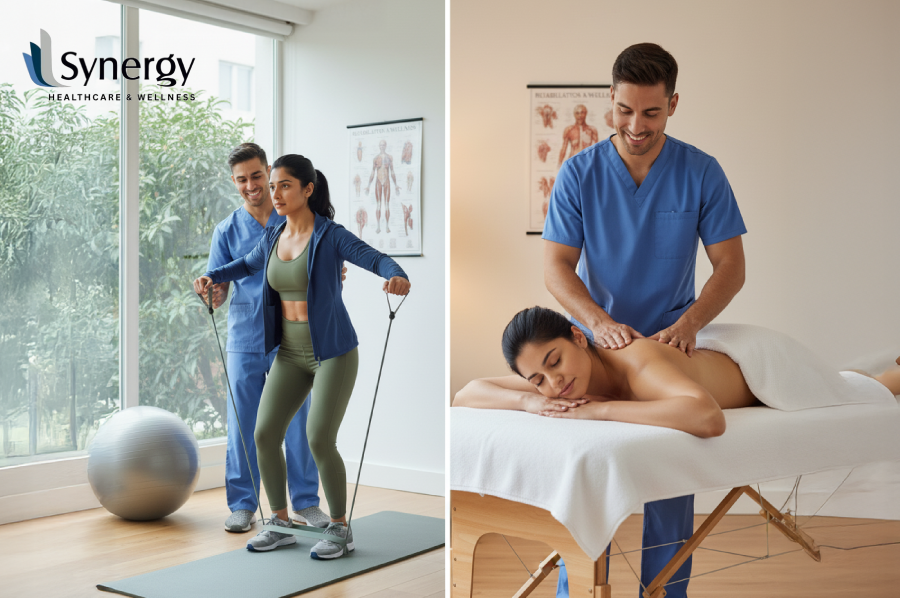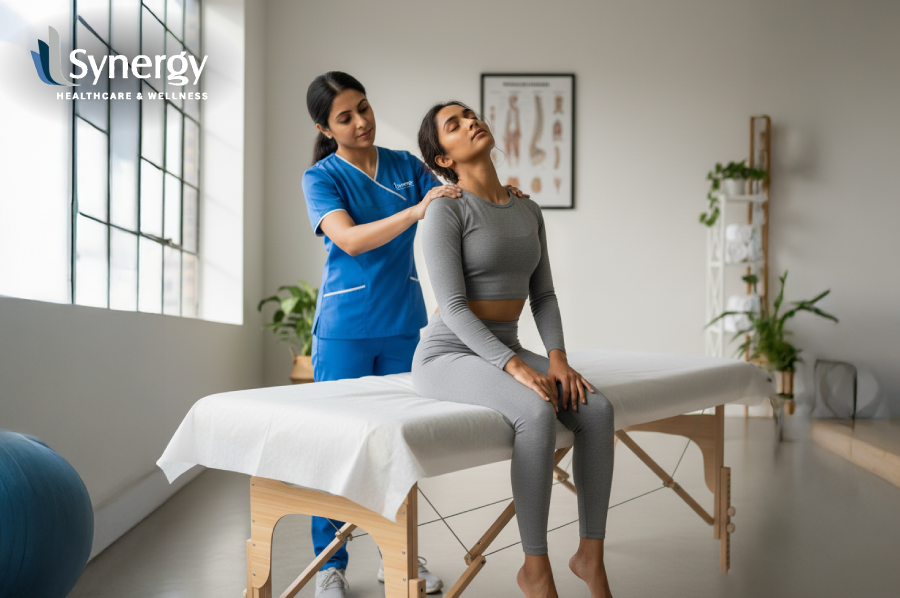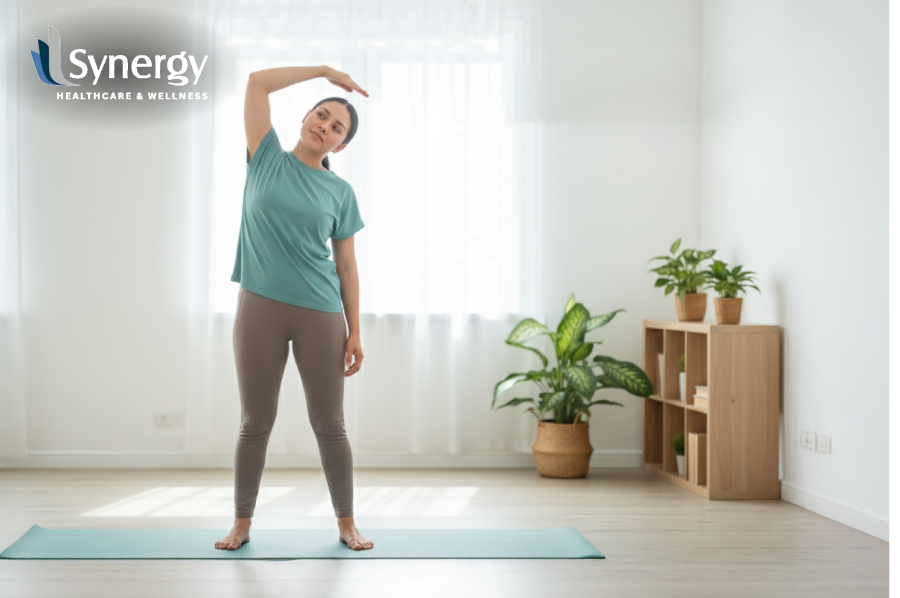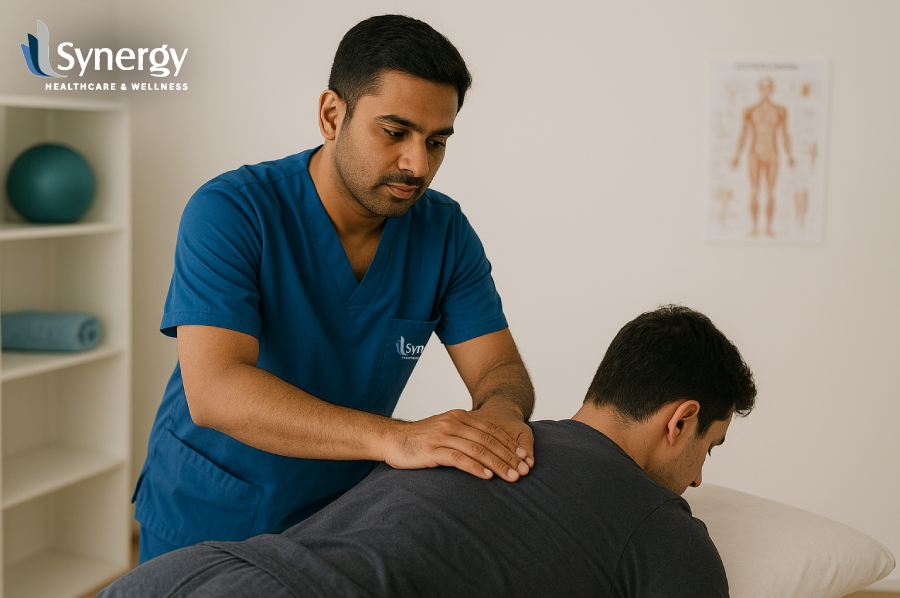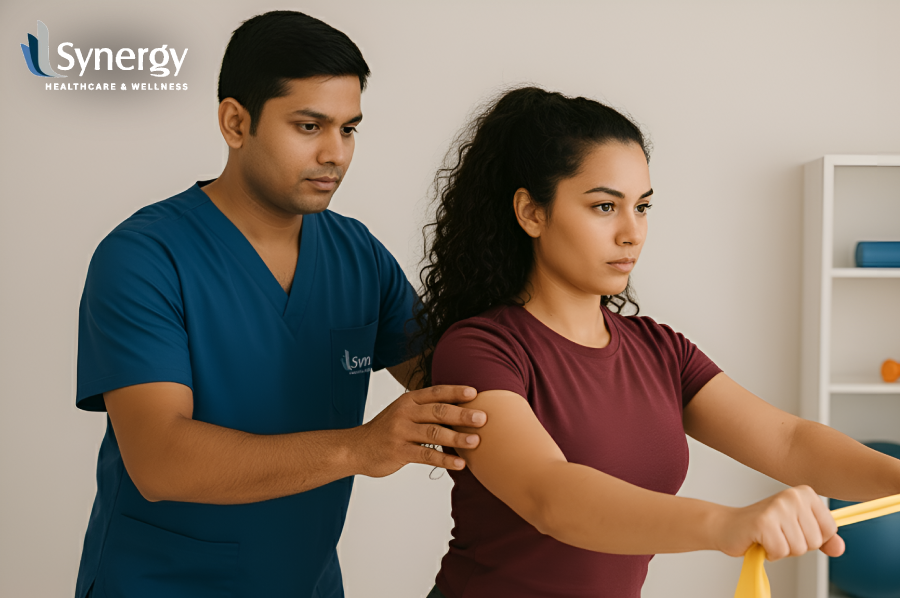Night leg cramps disrupt rest and signal underlying muscle imbalance or fatigue. Physiotherapy relieves these cramps through targeted stretching, strength training, and improved posture. A consistent routine restores mobility, enhances circulation, and helps ensure uninterrupted sleep.
Let’s Begin
Night leg cramps often strike without warning. One moment you are resting; the next, your calf or thigh muscle tightens so sharply that it feels impossible to move. These sudden contractions, called nocturnal leg cramps, are common among adults and older individuals. While quick stretching may help in the moment, lasting relief requires a structured approach. Physiotherapy for cramps offers that path, restoring flexibility and preventing recurring pain through targeted exercise and muscle retraining.
Understanding What Causes Leg Cramps at Night
Muscle fatigue and posture imbalance
During the day, muscles work continuously—standing, walking, climbing stairs, or even sitting for long hours. Fatigued or shortened muscles, especially in the calf and hamstring, often spasm when the body relaxes during sleep. Poor posture and limited flexibility further increase the strain on these muscle groups, creating a perfect setup for nighttime muscle tightening.
Circulation and nerve function
Restricted blood flow is another frequent factor. When circulation slows, the muscles receive less oxygen, and metabolic waste accumulates. This imbalance may trigger involuntary contractions in the lower legs. Certain nerve-related conditions or prolonged inactivity also contribute to muscle cramps in the legs at night, especially in those who spend long hours at a desk or who stand on hard surfaces all day.
Lifestyle and sleep triggers
Dehydration, low magnesium or potassium, and certain medications (such as diuretics) may intensify cramping. Alcohol consumption before bed, high caffeine intake, and sleeping in a position that shortens the calf muscles can also provoke these painful spasms. Physiotherapists address not only the muscles themselves but also these related habits, ensuring a comprehensive solution rather than temporary relief.
Why Physiotherapy Works for Night Leg Cramps
Stretching to restore flexibility
Physiotherapy begins by improving muscle length and joint mobility. Regular stretching of the calf, hamstring, and quadriceps helps prevent the sudden leg cramp wake-up that disturbs rest. Simple routines—like a gentle calf stretch before bed—train the muscle to relax through its full range of motion.
Strengthening to prevent fatigue
Tight muscles are often weak muscles. A physiotherapist designs progressive routines that strengthen the supporting structures of the legs, particularly the shin, ankle, and hip stabilisers. Stronger muscles resist fatigue and maintain better control, lowering the risk of involuntary muscle contraction in the legs during sleep.
Correcting gait and posture
When the body’s alignment shifts—through flat feet, knee rotation, or a tilted pelvis—the leg muscles must overwork to stabilise movement. A professional evaluation can identify these imbalances. Adjusting walking patterns and adding corrective drills can stop repetitive lower-leg strain, which otherwise leads to cramping after prolonged standing or walking.
A Step-by-Step Physiotherapy Programme for Night Leg Cramps
Physiotherapy progresses through three stages: assessment, active correction, and maintenance.
Step 1: Baseline assessment
A therapist first reviews daily habits and physical alignment. They check muscle tightness in the calves, hamstrings, and hip flexors, observe walking patterns, and test joint flexibility. This step ensures that your exercise plan addresses the exact cause of your nocturnal leg cramps rather than offering generic advice.
Step 2: Early-phase exercises (Week 1–2)
These movements target flexibility and light activation.
- Calf stretch against the wall: Stand facing a wall, one foot behind the other. Keep the back leg straight, heel grounded, and lean forward until a gentle stretch forms in the lower calf. Hold for 30 seconds and repeat three times.
- Hamstring stretch on bed edge: Sit with one leg extended and toes pointing up. Lean forward until tension is felt behind the thigh. Hold, breathe evenly, and release.
- Ankle circles: Sitting upright, rotate each ankle ten times clockwise and counter-clockwise to improve mobility.
These exercises loosen shortened fibres and improve circulation in lower-leg muscles prone to spasm.
Step 3: Strength-building phase (Week 3–4)
When flexibility improves, the focus turns to endurance and control.
- Resistance-band dorsiflexion: Secure a band around the ball of the foot and pull the toes toward you, resisting the tension. Repeat 15 times per leg.
- Heel raises: Stand upright and lift the heels slowly, balancing on the balls of the feet. Pause, then lower gradually. Two sets of 12 repetitions build calf strength and control.
- Toe-lift drill: With heels on the ground, lift your toes upward to activate the shin muscles. This balance between front and back leg muscles helps prevent night leg cramps by distributing effort evenly.
Step 4: Maintenance and self-care
Once strength returns, maintaining flexibility becomes crucial.
- A five-minute stretch routine before bed keeps the muscles supple.
- Gentle self-massage with a foam roller encourages blood flow.
- A short evening walk promotes healthy circulation. These habits sustain the benefits of physiotherapy long term, reducing both frequency and intensity of leg muscle spasms during sleep.
Lifestyle Habits That Support Physiotherapy
Hydration and electrolytes
Muscles need water and minerals to contract and release properly. Drinking throughout the day—not just before bed—prevents dehydration. Foods rich in magnesium, calcium, and potassium, such as bananas, leafy greens, and yoghurt, can reduce the occurrence of leg cramps at night.
Sleep posture and daily movement
A slightly elevated headboard or a pillow under the knees can improve blood return from the legs. Stretching before bed lengthens the muscles and decreases the risk of nighttime tightening. During the day, alternate sitting and standing, and take short movement breaks if your work requires long periods in one position. These small changes complement the effects of physiotherapy for cramps.
When to seek help
If night leg cramps occur frequently, disrupt sleep, or spread to other areas such as the feet or thighs, professional evaluation is essential. A physiotherapist or physician can rule out vascular, neurological, or metabolic causes and tailor a programme to your individual condition. Early management prevents chronic pain and maintains mobility.
Integrating the Programme into Everyday Life
Effective prevention depends on routine. Keep your stretch band near your bedside, so your nightly exercises become part of winding down. Track the nights you experience cramps and note improvements. This awareness helps maintain discipline and demonstrates the benefits of structured leg cramp physiotherapy.
Regular movement throughout the day is equally important. A ten-minute walk after dinner or gentle ankle rotations while sitting can make a measurable difference in circulation. Over time, these habits transform how your legs respond to rest, turning sleep from a source of discomfort into genuine recovery.
Healing Begins with the Right Hands
At Synergy Healthcare and Wellness in Chennai, we provide expert physiotherapy and rehabilitation services rooted in clinical integrity and personalised care. From the first consultation with a senior doctor through to guided recovery with our skilled physiotherapy team, each treatment plan is designed for lasting improvement. We address a broad range of conditions—from back and neck pain to sports injuries, post-surgical recovery and age-related movement issues—with thoughtful, structured pathways. Our goal is to restore pain-free mobility, improve quality of life, and support your body’s potential to heal.
Conclusion
Physiotherapy for cramps addresses both symptom and cause. Through guided stretching, strength training, and attention to posture, it restores balance to overworked leg muscles and reduces the painful interruptions of nocturnal leg cramps.
With consistent practice, healthy hydration, and mindful posture, your muscles learn to relax rather than contract during rest. The reward is simple yet powerful—quiet, uninterrupted sleep and refreshed legs ready for the day ahead.
FAQ’s
What is the main cause of night leg cramps?
Night leg cramps often result from muscle fatigue, dehydration, or restricted blood flow. Poor posture, limited flexibility, or standing for long hours can also strain the calf and hamstring muscles, triggering cramps during rest.
Can physiotherapy permanently stop night leg cramps?
Yes. Regular physiotherapy corrects muscle imbalance, strengthens weak areas, and improves circulation, reducing the frequency and intensity of cramps over time.
How often should I do physiotherapy exercises for leg cramps?
A short routine once or twice a day is ideal—morning stretches to activate the muscles and a gentle session before bed to prevent tightening during sleep.
Are night leg cramps harmful?
Occasional cramps are usually harmless, but persistent or severe episodes may point to circulation or nerve issues. Consistent physiotherapy exercises can greatly reduce the problem by training muscles to relax correctly.
How long does it take to see results?
Most people notice fewer cramps after two to three weeks of daily stretching and strengthening. Sustained improvement appears within two months when exercises are continued consistently.

